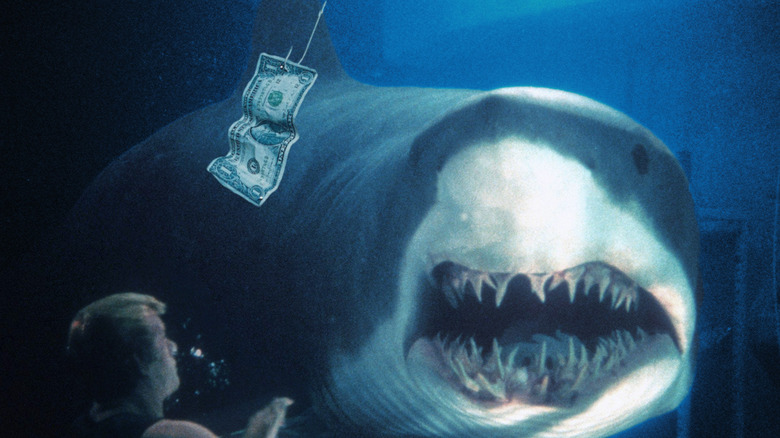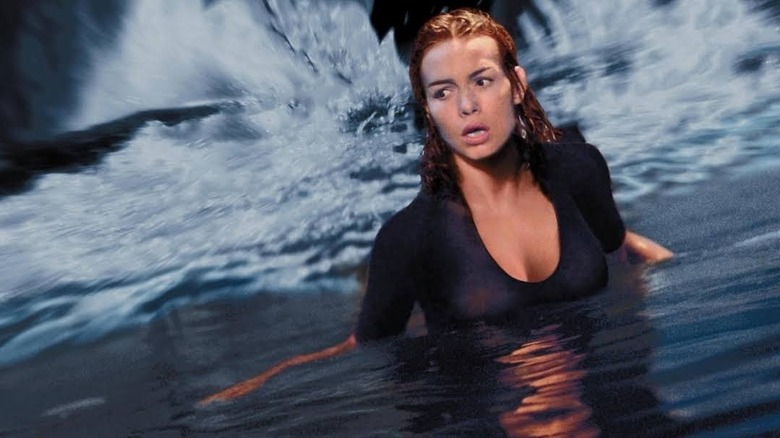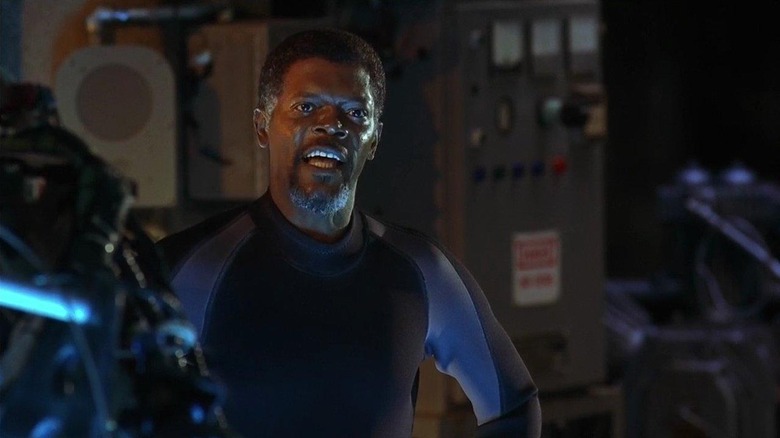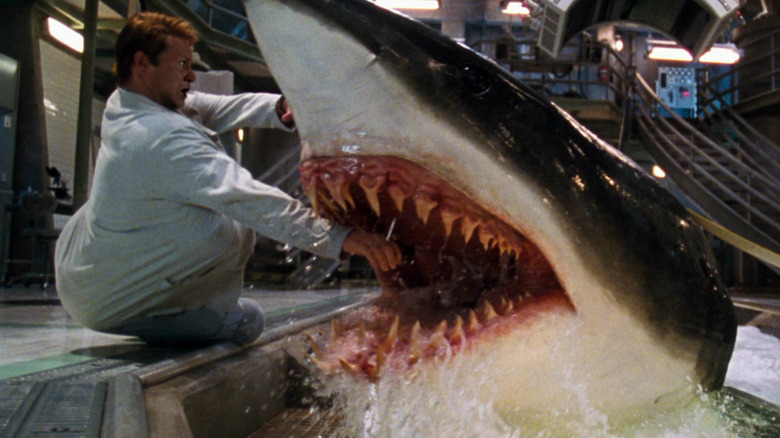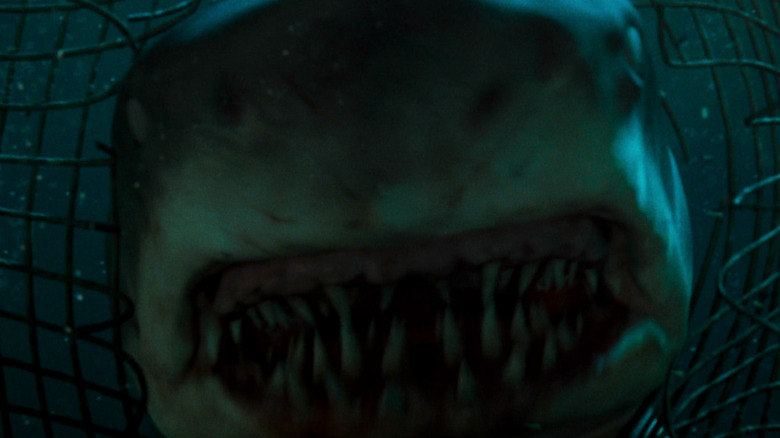Deep Blue Sea, The Second-Best Shark Movie Ever, Was Just A Modest Box Office Hit
(Welcome to Tales from the Box Office, our column that examines box office miracles, disasters, and everything in between, as well as what we can learn from them.)
"Scary, absurd, inessential." That's how critic David Denby described director Renny Harlin's 1999 shark movie "Deep Blue Sea" in his review for The New Yorker. I think it's fair to say that history agrees with his first two points. That third point, however? That one has been challenged greatly as the film was a success in its day and has gained a much larger following in the years since its theatrical run. It's now a franchise with two direct-to-video sequels. More than that, one could easily make the argument that it's the second-best shark movie ever made, only behind Steven Spielgerg's all-time blockbuster classic "Jaws."
Spielberg didn't invent the shark movie with "Jaws," but there was very much a dividing line between everything that came before "Jaws" and everything that came after. Every shark movie in the years since — and there have been some good ones — has, in some way, existed in that movie's shadow. "Deep Blue Sea" very successfully escaped that shadow by leaning into the absurdity. Yet, for all of the love and its ability to endure, Harlin's essential shark flick was but a modest hit at the box office in its day.
In this week's Tales from the Box Office, we're looking back at "Deep Blue Sea" in honor of its 25th anniversary. We'll go over how it came to be, how Harlin kept the movie's biggest surprises from being spoiled in the marketing, what happened when it hit theaters, how it became a cult movie in the years that followed, and what lessons we can learn all these years later. Let's dig in, shall we?
The movie: Deep Blue Sea
The film centers on a group of researchers working at an undersea lab where they house genetically altered sharks in the hopes of developing a cure for Alzheimer's. However, the genetic alterations made the sharks smarter and more aggressive. Trouble brews in the aftermath of a large storm, which damages the facility. Now, the group must fight for their lives as the sharks try to pick them off one by one.
Duncan Kennady first conceived of the story and wrote the first draft of the screenplay, which was subsequently rewritten several times by the likes of Donna Powers and Wayne Powers. Producing team Alan Riche and Tony Ludwig got their hands on the script in 1994 and then brought it to Warner Bros. Because it was such an ambitious undertaking requiring the right combination of production facility and technology, movement was slow at first. However, as Ludwig explained in the film's official production notes, things came together thanks in part to two very different movies: "Titanic" and "Free Willy."
"It took about 2 years to get to the point where we knew we could get the right picture made, and it really had less to do with what we were doing and more to do with the technology that had been created. In a confluence of events, 'Titanic' was just beginning to be developed, and Fox Baja Studios was being built for that movie. The 'Free Willy' series of pictures had become hugely successful utilizing constantly refined computer-driven animatronic technology. It was those two events, coupled with the development of this picture — all of it working at the same time — that brought us to the point where we could begin 'Deep Blue Sea.'"
Akiva Goldsman was also brought on board as a producer. As for Harlin? He was coming off of "The Long Kiss Goodnight" and, before that, 1995's "Cutthroat Island," which ranks as one of the most infamous box office bombs in history. Harlin needed a hit, and this movie needed Harlin.
Marketing Deep Blue Sea to the masses without spoiling the surprises
Harlin offered precisely what the producers were looking for. "Somebody who can grasp huge concepts and, at the same time, intimate, suspenseful drama," in their words, per the production notes. Thanks to the right director, the facilities, and visual effects technology in a post-"Jurassic Park" world, the movie finally began filming in August 1998. Harlin and the studio assembled quite the ensemble including Saffron Burrows ("Wing Commander"), Stellan Skarsgard ("Good Will Hunting"), rapper LL Cool J ("Halloween H20"), Thomas Jane ("Boogie Nights"), and the legend himself Samuel L. Jackson ("Pulp Fiction").
Jackson's inclusion was crucial because, spoiler alert, his character Russell Franklin suffered one of the most surprising deaths in cinema history. After working together on "Long Kiss Goodnight," Harlin and Jackon wanted to collaborate again. So, Harlin crafted the character specifically for Jackson. The death hit particularly hard because Jackson was the biggest star in the movie, so nobody saw it coming. That surprise played very well, but Warner Bros. originally wanted to spoil it in the marketing. As Harlin explained in an interview with /Film earlier this year:
"There was actually a big debate at the studio, Warner Brothers, over whether that scene should be included in the trailer of the movie. And I said, 'No way. That is the surprise of the movie. If you give it away in the trailer, then there's nothing left.' So we didn't, but yeah, that [scene] was just done because I wanted to have Sam in the movie."
In the end, Harlin crafted the polar opposite of "Jaws." It was state-of-the-art (for the time) CGI creations, a wacky/fun tone, and sharks invading the world where humans live — not the other way around. As Harlin mused in the production notes:
"What we have here is something more than we've seen before. We've seen sharks on the beach, sharks in the ocean. But here we see sharks in the living room, sharks in the bedroom, in this facility as it is flooding. I guess our motto for the movie is 'You can swim, but you can't hide.'"
The financial journey
With a budget between $60 and $82 million, Warner Bros. had a lot riding on this. The studio decided to lean into what set the film apart from other shark movies from years past. It wasn't just people in the water swimming for their lives. It was smark sharks. It was visuals we hadn't truly seen on screen before. It was deep sea craziness from the guy who made "Cliffhanger." It wasn't an homage to something old. Rather, it was something new.
The only downside is that when "Deep Blue Sea" opened in theaters on July 30, 1999, it was facing some steep competition. "Runaway Bride" arrived that weekend and topped the charts with $35 million, while the unexpected box office horror sensation "The Blair Witch Project" held firmly onto the number two spot in its second weekend with $29.2 million. That left Harlin's shark movie to settle for third place, taking in $19.1 million domestically. The following weekend made things even more complicated as M. Night Shyamalan's "The Sixth Sense" opened, swallowing the lion's share of attention. Still, these smart sharks held relatively strong with $11.2 million on weekend two.
"Deep Blue Sea" continued to swim upstream all summer and eventually finished its theatrical run with $73.66 million domestically to go with $91 million internationally for a grand total of $164.6 million worldwide. Now, depending on whether the budget was closer to $60 or $80 million makes a big difference here in considering the hit or flop status of this movie purely based on its theatrical run. Even at the top end, at best, all involved had to settle for a modest success story, whereas "Jaws" was a genre-defining success story that redefined the blockbuster for generations to come.
Deep Blue Sea finds life beyond the big screen
For various reasons, "Deep Blue Sea" didn't break out in theaters the way it might have under different circumstances. There was unexpectedly major competition and, frankly, audiences had never seen anything quite like it on a blockbuster scale before. "Up until that point, doing a shark picture meant heads above the water and underwater POV shots of flailing hands and feet," Akiva Goldsman pointed out in the production notes. While shots like that are a big part of the brilliance of "Jaws," at a certain point, that begins to feel tired after decades of homages or downright knockoffs.
But, over time, audiences caught up to Harlin's film. It did well on home video, benefiting from just about every format from VHS up through Blu-ray. It also made the rounds on cable long before Netflix and the advent of streaming led to a rise in cord-cutting. Appreciation grew for the film as well as the years went on. Writing for Wired in 2016, Brian Raftery declared it to be "the greatest non-Jaws shark movie of all time." It has been ranked right at or near the top of many shark movie lists, just below "Jaws." Time has been kind to this scary, absurd blockbuster.
As further evidence that the film performed well over the years outside of theaters, Warner Bros. eventually made a director-to-video sequel in 2018. While director Darin Scott's "Deep Blue Sea 2" was not highly regarded upon release, it did well enough to pave the way for another DTV sequel. Director John Pogue got it right, as 2020's "Deep Blue Sea 3" was met with very solid reviews, keeping the franchise alive for modern audiences. The whole "smart sharks terrorize humans" concept still has gas in the tank more than 20 years later.
The lessons contained within
Looking back, there are two things that stand out like a sore thumb to me regarding this movie. Trying to set aside my own, personal fondness for the film, a big part of why it has endured for 25 years is because it was not just another cheap imitation of what came before. Even the "Jaws" franchise devolved into that with its sequels, reaching a low point with "Jaws: The Revenge." Instead, all involved wanted to do something different, and, years later, that still strikes a chord with audiences. In attempting to emulate success, Hollywood would do well to remember that yes, doing the same thing can work a certain number of times, but the well eventually runs dry. New is needed, especially in well-trodden genres.
Beyond that, this is a premiere example of a movie where the box office numbers alone can't come close to telling the whole story. Even in a column completely devoted to discussing a movie through the lens of what it did at the box office, it's worth pointing out that the box office isn't everything. Heck, "Clerks III" only got made because "Jay and Silent Bob Strike Back" sold so many Blu-rays at a time when people always wanted to talk about the death of physical media. Even in the modern era, it's worth remembering that movies can have a long life beyond theaters, providing the space to find their audience.
While a certain portion of my musing here is dedicated to not going back to the well over and over again, it is worth pointing out that Harlin is getting back to the shark genre with a new film titled "Deep Water," which is being produced by Gene Simmons of KISS fame. Can Harlin reinvent the genre once again? Or is this going to be a situation where he plays the hits? Either way, he can probably at best hope to make the third-best shark movie of all time. The top two spots are comfortably occupied.
